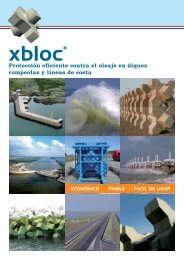xbloc-design-guidelines-2011.pdf (2.2MB)
xbloc-design-guidelines-2011.pdf (2.2MB)
xbloc-design-guidelines-2011.pdf (2.2MB)
Create successful ePaper yourself
Turn your PDF publications into a flip-book with our unique Google optimized e-Paper software.
Guidelines for Xbloc Concept Designs<br />
Guidelines for Xbloc Concept Designs<br />
®<br />
<strong>xbloc</strong><br />
Edition September 2011<br />
<strong>xbloc</strong><br />
®
1<br />
Guidelines for Xbloc Concept Designs<br />
Guidelines for Xbloc Concept Designs<br />
Edition September 2011
2 Guidelines for Xbloc Concept Designs
Contents<br />
3<br />
Guidelines for Xbloc Concept Designs<br />
1 Introduction<br />
2 Symbols and Definitions<br />
3 Starting Points and Boundary Conditions<br />
4 Front Armour Design<br />
4.1 Required Xbloc size<br />
4.2 Local phenomena that affect the required unit size<br />
4.3 Maximum allowable number of rows<br />
5 Toe Design<br />
5.1 Depth variation along alignment<br />
5.2 Sandy seabed<br />
5.3 Rocky seabed<br />
5.4 Size of rock toe in front of Xbase unit<br />
6 Crest Design<br />
7 Rear Armour Design<br />
8 Breakwater Head and Curved Sections<br />
9 Transitions<br />
9.1 Transitions between Xbloc sizes<br />
9.2 Transitions between Xbloc sections and rock sections<br />
4<br />
5<br />
6<br />
7<br />
11<br />
13<br />
15<br />
16<br />
17<br />
10 Conditions of Use<br />
18<br />
Xbase<br />
Xbloc
1 Introduction<br />
4 Guidelines for Xbloc Concept Designs<br />
Over the last decades, Delta Marine Consultants (DMC) has gained a vast experience in<br />
the <strong>design</strong> of breakwaters and shore protections. Following the development of Xbloc<br />
which started in 2001 and its market introduction in 2003, DMC has been involved in<br />
<strong>design</strong>, physical model testing and construction of many Xbloc projects around the<br />
world.<br />
The objective of this document is to share this experience with <strong>design</strong> consultants who<br />
are working on concept <strong>design</strong>s with Xbloc armour units. Although the required Xbloc<br />
unit size is determined mainly by the <strong>design</strong> wave conditions, a number of phenomena<br />
is presented in this document which may require the application of a larger unit<br />
size than purely based on the <strong>design</strong> wave height. Furthermore typical details are<br />
presented such as the toe, crest and head of a breakwater and transitions.<br />
This document is not a <strong>design</strong> manual and it is not a complete description of all factors<br />
that affect a <strong>design</strong>. The objective of this document is to provide general information<br />
to be used for concept <strong>design</strong>s with Xbloc armour units. The <strong>design</strong> remains the<br />
responsibility of the <strong>design</strong>er who shall take into account the various factors that<br />
affect the <strong>design</strong>. Physical model tests are always recommended by DMC to verify the<br />
stability of the <strong>design</strong>. The conditions which apply to the use of this document are<br />
described in Section 10.<br />
In case of questions about a concept <strong>design</strong> or about the use of Xbloc, please feel free<br />
to contact DMC at:<br />
• <strong>xbloc</strong>@<strong>xbloc</strong>.com;<br />
• dmc@dmc.nl;<br />
• +31 182 590 610
2 Symbols and Definitions<br />
5 Guidelines for Xbloc Concept Designs<br />
The following symbols are used in this document:<br />
Symbol Description Unit<br />
D Xbloc unit height m<br />
D n50<br />
Median nominal diameter of rock m<br />
Δ Relative concrete density -<br />
D x<br />
Horizontal c.t.c. distance between Xblocs along alignment m<br />
D y<br />
Upslope c.t.c. distance between Xblocs m<br />
H s<br />
Significant wave height based on time domain analysis m<br />
H mo<br />
Significant wave height calculated from wave spectrum m<br />
h t<br />
Water depth above rock toe m<br />
h Water depth m<br />
N Packing density of Xblocs on slope units/m 2<br />
N od<br />
Damage value; number of displaced rocks -<br />
ρ w<br />
Mass density of seawater kg/m 3<br />
ρ c<br />
Mass density of concrete kg/m 3<br />
T p<br />
Peak wave period s<br />
V Xbloc unit volume m 3<br />
W Xbloc unit mass t<br />
The following definitions are used in this document:<br />
(the numbers shown refer to Figure 2-1)<br />
Armour layer (1) Outer layer of structure<br />
Core (4) Inner part of breakwater<br />
Crest height (5) Top level of structure<br />
Crown wall (6) Concrete structure placed on breakwater crest<br />
Filter (8) Filter layer between sea bed and breakwater toe<br />
Freeboard (7) The crest height above <strong>design</strong> high water level<br />
Relative Freeboard the freeboard divided by the <strong>design</strong> wave height<br />
Under layer (2) Rock layer between core and armour layer<br />
Toe (3) Rock protection; foundation of armour layer<br />
5<br />
7<br />
6<br />
H s,<strong>design</strong><br />
8<br />
1<br />
2 4<br />
3<br />
Figure 2-1: Typical outline symbols and definitions
3 Starting Points and Boundary Conditions<br />
6<br />
Guidelines for Xbloc Concept Designs<br />
The most important starting points for the <strong>design</strong> of a breakwater / shore protection<br />
are:<br />
• The required lifetime of the structure;<br />
• The return period of the <strong>design</strong> conditions;<br />
• Allowable overtopping;<br />
• Allowable wave disturbance behind a breakwater;<br />
• Construction aspects (e.g. crest width and height).<br />
The most important boundary conditions for the <strong>design</strong> of a breakwater / shore<br />
protection are:<br />
• The <strong>design</strong> wave height and period;<br />
• The <strong>design</strong> water level (high water and low water);<br />
• The bathymetry;<br />
• The soil conditions;<br />
• Seismic conditions.<br />
The geotechnical <strong>design</strong> of breakwaters and shore protections is determined by local<br />
soil conditions, surcharge loads, hydraulic loads and seismic conditions. These aspects<br />
should be carefully considered by the <strong>design</strong> consultant and are not a part of this<br />
document.
7 Guidelines for Xbloc Concept Designs<br />
4 Front Armour Design<br />
The required armour size is typically determined by the <strong>design</strong> wave height as<br />
described in Section 4.1. Depending on the local conditions, there are however<br />
phenomena that may require the application of a larger unit than based on the<br />
equation in Section 4.1. These phenomena are described in Section 4.2.<br />
4.1 Required Xbloc size<br />
For the <strong>design</strong> of typical cross sections of breakwaters and shore protections, the<br />
required Xbloc size depends on the <strong>design</strong> wave height and can be determined with the<br />
following formula:<br />
V =<br />
Where:<br />
7<br />
3<br />
H s<br />
2.77 x Δ<br />
V Xbloc volume [m 3 ]<br />
H s<br />
Design significant wave height 1) 2) [m]<br />
Δ Relative concrete density (ρ c<br />
- ρ w<br />
) /ρ w<br />
[-]<br />
ρ w<br />
Mass density of seawater [kg/m 3 ]<br />
ρ c<br />
Mass density of concrete 3) [kg/m 3 ]<br />
1)<br />
DMC does not recommend a reduction for oblique waves without physical model tests.<br />
2)<br />
If H mo<br />
is higher than H s<br />
, H mo<br />
shall be applied.<br />
3)<br />
DMC does not recommend the use of concrete densities outside the range of 2350-2500kg/m 3 .<br />
This formula in fact gives the same results as the Hudson Formula for an armour slope<br />
steepness of 3V:4H and a K d<br />
factor of 16. Please note that for Xbloc on a milder slope,<br />
the required unit weight is not reduced.<br />
Xblocs are typically applied on an armour slope steepness between 3V:4H and 2V:3H.
4 Front Armour Design<br />
8 Guidelines for Xbloc Concept Designs<br />
The above formula results in the following Xbloc Design Table which is based on<br />
ρ concrete<br />
= 2400 kg/m 3 and ρ seawater<br />
= 1030 kg/m 3<br />
Unit Design Unit Unit Thickness Packing Concrete Placement Placement Porosity Rock Thickness<br />
volume wave height weight of armour density volume distance distance of grading for under layer<br />
height layer horizontal up-slope armour layer under layer<br />
V H s<br />
D W h N D x<br />
D y<br />
f<br />
[m 3 ] [m] [m] [t] [m] [1/100m 2 ] [m 3 /m 2 ] [m] [m] [%] [t] [m]<br />
0.75 3.35 1.31 1.8 1.3 70.03 0.53 1.73 0.83 58.7 0.06-0.3 0.8<br />
1 3.69 1.44 2.4 1.4 57.81 0.58 1.90 0.91 58.7 0.06-0.3 0.8<br />
1.5 4.22 1.65 3.6 1.6 44.12 0.66 2.18 1.04 58.7 0.3-1.0 1.3<br />
2 4.65 1.82 4.8 1.8 36.42 0.73 2.40 1.14 58.7 0.3-1.0 1.3<br />
2.5 5.01 1.96 6.0 1.9 31.38 0.78 2.58 1.23 58.7 0.3-1.0 1.3<br />
3 5.32 2.08 7.2 2.0 27.79 0.83 2.75 1.31 58.7 0.3-1.0 1.3<br />
4 5.86 2.29 9.6 2.2 22.94 0.92 3.02 1.44 58.7 0.3-1.0 1.3<br />
5 6.31 2.47 12.0 2.4 19.77 0.99 3.26 1.55 58.7 1.0-3.0 1.8<br />
6 6.70 2.62 14.4 2.5 17.51 1.05 3.46 1.65 58.7 1.0-3.0 1.8<br />
7 7.06 2.76 16.8 2.7 15.80 1.11 3.64 1.74 58.7 1.0-3.0 1.8<br />
8 7.38 2.88 19.2 2.8 14.45 1.16 3.81 1.82 58.7 1.0-3.0 1.8<br />
9 7.67 3.00 21.6 2.9 13.36 1.20 3.96 1.89 58.7 1.0-3.0 1.8<br />
10 7.95 3.11 24.0 3.0 12.45 1.25 4.10 1.96 58.7 1.0-3.0 1.8<br />
12 8.44 3.30 28.8 3.2 11.03 1.32 4.36 2.08 58.7 1.0-3.0 1.8<br />
14 8.89 3.48 33.6 3.4 9.95 1.39 4.59 2.19 58.7 3.0-6.0 2.4<br />
16 9.29 3.63 38.4 3.5 9.10 1.46 4.80 2.29 58.7 3.0-6.0 2.4<br />
18 9.67 3.78 43.2 3.7 8.42 1.52 4.99 2.38 58.7 3.0-6.0 2.4<br />
20 10.01 3.91 48.0 3.8 7.85 1.57 5.17 2.47 58.7 3.0-6.0 2.4
4 Front Armour Design<br />
9 Guidelines for Xbloc Concept Designs<br />
4.2 Local phenomena that affect the required unit size<br />
The <strong>design</strong> formula and <strong>design</strong> table presented in the previous section are applicable<br />
for typical cross sections of breakwaters and shore protections. There is however a<br />
number of phenomena which require to increase the Xbloc size. The phenomena and<br />
the proposed correction factor on the unit weight are described below.<br />
Phenomenon Effect on Armour Stability Correction factor on unit weight<br />
Units are placed on a breakwater<br />
head or on curved sections<br />
Accurate placement in a staggered grid is complicated by the breakwater geometry and wave impact is<br />
affected by the geometry, therefore the stability is reduced.<br />
1.25<br />
Frequent occurrence of near<strong>design</strong><br />
wave height during the<br />
lifetime of the structure<br />
Rocking of units, which can occur for a small percentage of the armour units during the <strong>design</strong> event of a<br />
breakwater, can occur frequently during the lifetime of the structure. Therefore rocking should be carefully<br />
assessed during the physical model tests.<br />
1.25<br />
The foreshore in front of the<br />
structure is steep<br />
A steep foreshore can lead to adverse wave impact against the armour layer. 1.1 for a steepness between 1:30 and 1:20<br />
1.25 for a steepness between 1:20 and 1:15<br />
1.5 for a steepness between 1:15 and 1:10<br />
2 for a steepness greater than 1:10<br />
The structure is low crested<br />
Armour units placed on the horizontal crest and high on the slope are less stable than units placed lower on<br />
the slope, where interlocking is increased by gravity and the above-lying units. In case of a low breakwater,<br />
the crest area sustains significant wave impacts and as a consequence a larger unit size is applied.<br />
2 for a relative freeboard < 0.5<br />
1.5 for a relative freeboard < 1<br />
The water depth is large<br />
For typical nearshore breakwater cross sections, the ratio between the highest wave heights in the spectrum<br />
and the significant wave height is in the order of 1.2 – 1.4. For breakwaters in deep water, this ratio can be up<br />
to 1.8 – 2. As the largest waves in the spectrum cause the largest loads on the armour layer, the stability of<br />
the armour layer is reduced compared to breakwaters in lower water depths.<br />
Furthermore a breakwater cross section in deep water typically contains a high rock toe which can affect the<br />
wave impacts on the armour slope. Therefore rocking should be carefully assessed during the physical model<br />
tests.<br />
1.5 for a water depth > 2.5 x H s<br />
2 for a water depth > 3.5 x H s<br />
The core permeability is low<br />
A low core permeability can lead to large pressures in the armour layer and reduce the stability of the<br />
armour layer. The permeability of the core depends on the materials used and the distance at the water line<br />
between the armour layer and the impermeable layer.<br />
1.5 for a low core permeability<br />
2 for an impermeable core<br />
The armour slope is mild (
4 Front Armour Design 10 Guidelines for Xbloc Concept Designs<br />
For the concept <strong>design</strong> of structures where one or more of these phenomena apply, the<br />
following <strong>design</strong> formula is recommended:<br />
V =<br />
H s<br />
2.77 x Δ<br />
x correction factor<br />
3<br />
If more than one of the above-mentioned phenomena is applicable to a <strong>design</strong>, it is<br />
advised to apply the largest correction factor as a starting point for the physical model<br />
tests.<br />
These correction factors are presented with the objective to make <strong>design</strong>ers aware<br />
of the effect of these phenomena and to give a first estimate of the required Xbloc<br />
size in a project. It should be noted that the factors presented should be used with<br />
care as these are based more on project specific model test experience rather than<br />
on vast research programs. For the detailed <strong>design</strong>, physical model tests are always<br />
recommended.<br />
Although this document focuses on the <strong>design</strong> of Xbloc breakwaters and shore<br />
protections, DMC expects that the phenomena described above apply to all armour<br />
units which derive their stability from interlocking.<br />
4.3 Maximum allowable number of rows<br />
Another phenomenon which may require to apply a larger armour unit than purely<br />
based on the <strong>design</strong> formula presented in section 4.1 is a long breakwater slope.<br />
19D Y<br />
+ 0.5D<br />
To limit possible settlements the maximum number of rows on the slope is 20. This<br />
results in a maximum slope length of 19 x D y<br />
+ 0.5 x D where D y<br />
is the upslope distance<br />
between the Xblocs and D is the characteristic height of the Xbloc.<br />
If the slope length requires more than 20 rows, there are 2 possible solutions:<br />
• Increase the unit size and/or;<br />
• Raise the toe level by applying a rock berm.<br />
D Y<br />
It should be noted that applying a berm may affect the wave impacts on the armour<br />
slope. Therefore this solution may still lead to applying a larger armour unit.<br />
XBASE<br />
Figure 4-1: Maximum slope length
5 Toe Design<br />
11<br />
Guidelines for Xbloc Concept Designs<br />
For the <strong>design</strong> of the toe, the combination of wave heights and water level shall be<br />
carefully considered. In a depth limited situation the toe <strong>design</strong> shall be checked for<br />
various water levels with corresponding wave height combinations. If the <strong>design</strong> wave<br />
conditions can occur during <strong>design</strong> low water level, this combination will be governing.<br />
5.1 Depth variation along alignment<br />
If the water depth varies along the breakwater alignment, the number of Xblocs on<br />
the slope will vary along the alignment. DMC generally recommends to <strong>design</strong> the<br />
breakwater toe in such a way that it follows the seabed (hence not to <strong>design</strong> sudden<br />
steps along the alignment). The maximum gradient for which this is recommended<br />
is 1V:10H. For steeper gradients, the toe should be levelled either by filling with rock<br />
material or by dredging.<br />
5.2 Sandy seabed<br />
For a sandy seabed DMC recommends the following toe geometry:<br />
• A rock filter layer or a geotextile with a protective small rock layer on top;<br />
• Foundation layer underneath the Xbase units. Typically the rock size applied in<br />
this layer has a W 50<br />
of the Xbloc weight divided by 30;<br />
• A row of Xbase units (for easy placement of the first row of armour units);<br />
• A rock toe in front of the Xbase units.<br />
MIN 3XDn50<br />
MIN 2XDn50<br />
MIN 1 X H S<br />
MIN 0.5m<br />
ROCK TOE<br />
GRANULAR FILTER<br />
GEOTEXTILE (OPTIONAL) LAYER(S)<br />
XBASE<br />
XBASE FOUNDATION LAYER + W/30<br />
Figure 5-1: Typical toe layout on sandy seabed (if required a geotextile shall be applied<br />
between seabed and core layer)<br />
The minimum dimensions of the rock toe are indicated in Figure 5-1. In section 5.4 the<br />
required mass of the rock is described.<br />
In very shallow water depths, it may be impossible to <strong>design</strong> a toe as shown in<br />
Figure 5-1 as the required rock size becomes too large. In such situations, it can be<br />
considered to dig a trench below the planned breakwater toe and fill this trench with<br />
rock layers (see Figure 5-2). This geometry is also suitable in situations with a risk of<br />
scour.<br />
MIN 3XDn50<br />
MIN 2XDn50<br />
XBASE<br />
GRANULAR FILTER<br />
LAYER(S)<br />
ROCK TOE<br />
Figure 5-2: Toe layout on sandy seabed in very shallow water depths
5 Toe Design<br />
12<br />
Guidelines for Xbloc Concept Designs<br />
5.3 Rocky Seabed<br />
For a rocky seabed, the toe geometry is slightly different as there is no need for filter<br />
layers. In this case the toe consists of:<br />
• A row of Xbase units placed on the seabed;<br />
• A rock toe in front of the Xbase units.<br />
The minimum dimensions of the toe on a rocky seabed are indicated in Figure 5-3. In<br />
section 5.4 the required mass of the rock is described.<br />
For the detail as shown in Figure 5-3, the smoothness and gradient of the seabed<br />
should be considered. If the roughness of the seabed is larger than D/4 or if the<br />
gradient of the seabed is larger than 1V:10H, the toe <strong>design</strong> as per Figure 5-1 is<br />
recommended.<br />
5.4 Size of rock toe in front of Xbase unit<br />
The required rock size depends on the water depth and the wave height. A prediction<br />
of required rock mass can be derived by generic approach developed by Van der Meer<br />
et al (1995). The formula derived by Van der Meer is given below:<br />
MIN 3XDn50<br />
XBASE<br />
Figure 5-3: Typical toe layout on rocky seabed<br />
MIN 2XDn50<br />
ROCK TOE<br />
D n50<br />
=<br />
H s<br />
2.7<br />
h t<br />
0.15<br />
2 + 6.2 x N od<br />
Δ<br />
h<br />
Where<br />
D n50<br />
Median nominal diameter of rock [m]<br />
H s<br />
Design significant wave height [m]<br />
h t<br />
Depth above toe [m]<br />
h Water depth in front of toe [m]<br />
N od<br />
Damage value Number of displaced units [-]<br />
Δ Relative concrete density (ρ c<br />
- ρ w<br />
) /ρ w<br />
[-]<br />
ρ w<br />
Mass density of seawater [kg/m 3 ]<br />
ρ c<br />
Mass density of concrete [kg/m 3 ]<br />
It is recommended to <strong>design</strong> the required toe size with a N od<br />
value of 0.5 (start of<br />
damage), a higher value is not recommended as it may lead to settlement of the Xbloc<br />
armour layer.
6 Crest Design<br />
13 Guidelines for Xbloc Concept Designs<br />
The <strong>design</strong> of the breakwater crest depends on:<br />
• The required crest level;<br />
• Whether or not road access is required on the breakwater and by whom it will be<br />
used (access road or service road only);<br />
• The allowable overtopping;<br />
• The crest width at a certain level required for construction purposes.<br />
Figures 6-1 and 6-2 give an overview of typical crest <strong>design</strong>s depending on the relative<br />
freeboard and whether or not access to the breakwater is required (with a crown<br />
element or not). The crown elements given in Figure 6-2 are indicative only. The<br />
hydraulic stability of the crown elements can be critical and shall be assessed in a<br />
concept <strong>design</strong>.<br />
It should be noted that these are typical sketches and that physical model tests are<br />
recommended for the crest <strong>design</strong>, especially if the freeboard is low.<br />
If the breakwater has a relative freeboard of 0.8 – 1.2, it is recommended to place at<br />
least 2 armour units in front of the crown wall. This corresponds to a width of 1.64D<br />
where D is the characteristic unit height. Without a crown wall it is recommended to<br />
apply at least 3 armour units on the crest, which corresponds to a minimum crest<br />
width of 2.28D.<br />
In case the crest height of the breakwater has a relative freeboard of 1.2 – 1.5 the<br />
recommended minimum crest width in front of a crown wall is 1D, which corresponds to<br />
placing 1 unit on the crest.
6 crest Design<br />
14<br />
Guidelines for Xbloc Concept Designs<br />
Relative Freeboard<br />
Without Crown Wall<br />
With Crown Element<br />
Relative Freeboard<br />
1.64D<br />
0.8-1.2<br />
H s<br />
ROCK UNDERLAYER<br />
XBLOC<br />
4<br />
3<br />
ROCK CORE<br />
4<br />
3<br />
1.2H s<br />
0.5H s<br />
H s<br />
ROCK UNDERLAYER<br />
XBLOC<br />
4<br />
3<br />
ROCK CORE<br />
1.2H s<br />
3<br />
2<br />
ARMOUR LAYER W/2<br />
>1D<br />
>1D<br />
1.2-1.5 1.2-1.5<br />
XBLOC<br />
XBLOC<br />
ROCK UNDERLAYER<br />
H s<br />
4<br />
3<br />
ROCK CORE<br />
1.5H s<br />
3<br />
2<br />
ARMOUR LAYER W/2<br />
ROCK UNDERLAYER<br />
H s<br />
4<br />
3<br />
3 ROCK CORE<br />
2<br />
1.5H s<br />
ARMOUR LAYER W/2<br />
>1.5 PAVEMENT<br />
>1.5<br />
XBLOC<br />
XBLOC<br />
ROCK UNDERLAYER<br />
>1.5H s<br />
ROCK UNDERLAYER<br />
>1.5H s<br />
H s<br />
4<br />
3<br />
3 ROCK CORE<br />
2<br />
H s<br />
4<br />
3<br />
3 ROCK CORE<br />
2<br />
Figure 6-1: Typical crest and rear armour <strong>design</strong> without crest structure<br />
(depending on relative freeboard)<br />
Figure 6-2: Typical crest and rear armour <strong>design</strong> with crest structure<br />
(depending on relative freeboard)
7 Rear Armour Design<br />
15<br />
Guidelines for Xbloc Concept Designs<br />
The <strong>design</strong> of the rear armour is determined by:<br />
• The overtopping waves;<br />
• The waves at the rear side of the breakwater (mostly as a result of wave<br />
penetration).<br />
In this section it is assumed that the wave climate at the rear side of the breakwater is<br />
calm (hence no significant wave penetration, ship induced waves etc.).<br />
There is no generic <strong>design</strong> formula for rear armour as the geometry of the breakwater<br />
has a large impact on the overtopping volume and on the wave impacts on the rear<br />
armour. Figure 6-1 and Figure 6-2 give an overview of the rear armour at typical<br />
breakwater cross sections depending on the relative freeboard and whether or not<br />
access to the breakwater is required.<br />
Please note that these are typical sketches and that physical model tests are required<br />
for detailed rear armour <strong>design</strong>.
16<br />
Guidelines for Xbloc Concept Designs<br />
8 Breakwater Head and Curved Sections<br />
In general the breakwater head is the most exposed part of the breakwater. The<br />
armour at this section is <strong>design</strong>ed with a correction factor of 1.25 as described in<br />
Section 4-2. This means that the weight of the Xbloc armour units at the head section<br />
is 25% heavier than the units at the trunk section.<br />
The exposed bends of the breakwater shall also be <strong>design</strong>ed with Xbloc armouring<br />
which is 25% heavier than what would be required for a straight trunk section.<br />
The minimum radius of a breakwater head section with Xbloc armour is 2.5 times<br />
the <strong>design</strong> H S<br />
taken at <strong>design</strong> high water level (DHWL). If a larger armour unit is<br />
applied than based on a correction factor of 1.25, the minimum radius is 5.9 times the<br />
characteristic height (D) of the Xbloc size.<br />
A typical <strong>design</strong> of a breakwater head is shown in Figure 8-1.<br />
Harbour<br />
R=2.5H s<br />
at <strong>design</strong> water<br />
level<br />
sea<br />
Trunk<br />
1.64D<br />
1.64D<br />
SEA SIDE<br />
4<br />
3<br />
4<br />
3<br />
LEE SIDE<br />
H s<br />
ROCK CORE<br />
Figure 8-1: Typical <strong>design</strong> breakwater head
9 Transitions<br />
17<br />
Guidelines for Xbloc Concept Designs<br />
9.1 Transitions between Xbloc sizes<br />
Transitions between Xbloc sizes are required if multiple unit sizes are applied along a<br />
breakwater / shore protection.<br />
The maximum recommended step is a doubling of the unit size (e.g. from 2m 3 to 4m 3<br />
units).<br />
The entire transition shall be located in the area where the smallest unit size is stable.<br />
9.2 Transitions between Xbloc sections and rock sections<br />
At the transition from Xbloc armour to rock armour, the Xbloc armour will be ended in<br />
a triangle shape as shown in Figure 9-1. This triangle shall be covered by suitable rock.<br />
Figure 9-1: Typical transition rock-Xbloc and Xbloc-Xbloc
10 Conditions of use<br />
18<br />
Guidelines for Xbloc Concept Designs<br />
Delta Marine Consultants [DMC] is a trademark of BAM Infraconsult B.V., a private<br />
company with limited liability, with registered office at H.J. Nederhorststraat 1,<br />
Gouda, The Netherlands.<br />
DMC is holder of several patents, patent applications and trademarks in relation to the<br />
Xbloc unit and Xbase unit. The Xbloc unit and the Xbase unit are known and legally<br />
protected by the trademarks Xbloc and Xbase.<br />
For the use of Xbloc, a signed Xbloc License Agreement is required between Client and<br />
DMC.<br />
In this document DMC provides some considerations for <strong>design</strong>ers who intend to<br />
incorporate Xbloc armour units in a <strong>design</strong> (further referred as Designer).<br />
The following conditions apply to the <strong>guidelines</strong> presented by DMC in this document.<br />
• This document is based on DMC’s current professional insights. Changes in these<br />
insights may lead to changes in the contents of this document. Before using this<br />
document, Designer is requested to check if this document is the latest revision.<br />
• This document does not contain a complete description of all factors that affect<br />
a <strong>design</strong>.<br />
• Designer shall be responsible for <strong>design</strong>s made by using the contents of this<br />
document and shall take into account the various factors that affect the <strong>design</strong>.<br />
• DMC shall not be liable for any direct and/or indirect or consequential damages<br />
or losses such as loss of revenue, loss of profit, loss of anticipated profit, loss of<br />
use, production, product, productivity, facility downtime and business opportunity<br />
resulting from the contents of this document.<br />
• The <strong>guidelines</strong> provided by DMC regarding the <strong>design</strong> with Xbloc armour units are<br />
subject to confirmative physical model tests.<br />
• All information provided by DMC concerning (the application of) Xbloc is<br />
proprietary information of DMC. It shall not be disclosed by <strong>design</strong>er to any third<br />
parties.<br />
• The relationship between Designer and DMC shall be governed by the law of The<br />
Netherlands and any disputes arising out of or in connection with the work carried<br />
out by DMC shall finally be settled by the competent courts in The Hague.
Guidelines for Xbloc Concept Designs<br />
Delta Marine Consultants<br />
H. J. Nederhorststraat 1<br />
P.O. Box 268<br />
2800 AG Gouda<br />
The Netherlands<br />
T +31 182 590 610<br />
E <strong>xbloc</strong>@<strong>xbloc</strong>.com, dmc@dmc.nl<br />
Delta Marine Consultants Pte. Ltd<br />
(Singapore Branch)<br />
6001 Beach Road<br />
#20-03 Golden Mile Tower<br />
Singapore 199589<br />
T +65 62 943 033<br />
E <strong>xbloc</strong>@<strong>xbloc</strong>.com, dmc@dmc.nl<br />
®<br />
<strong>xbloc</strong><br />
Delta Marine Consultants is a trademark of BAM Infraconsult bv


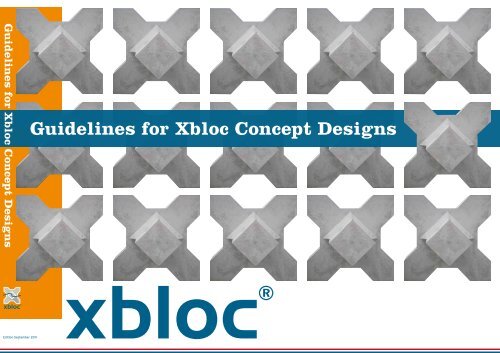
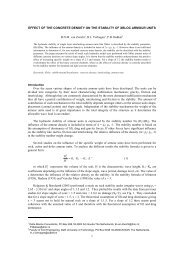
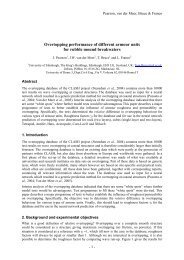
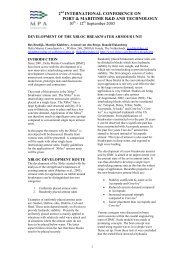
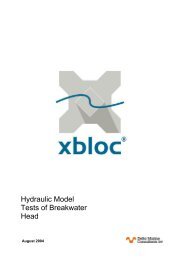
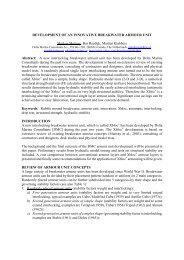
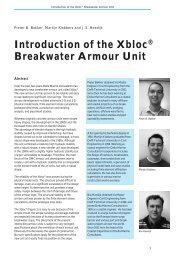
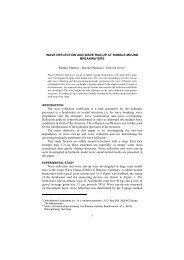
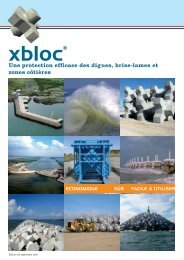
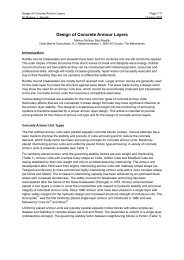
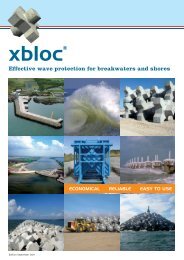
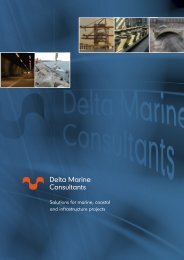

![Frequently Asked Questions about the Xbloc ® unit [FAQ]](https://img.yumpu.com/24141057/1/184x260/frequently-asked-questions-about-the-xbloc-aar-unit-faq.jpg?quality=85)
